The Impact of Trees on the UHI Effect and Urban Environment Quality: A Case Study of a District in Pisa, Italy
Abstract
:1. Introduction
2. Materials and Methods
2.1. Case study: Porta a Lucca, Pisa
- Street arrangement 1 (SA1), with large street trees, i.e., Stone pine (Pinus pinea L.);
- Street arrangement 2 (SA2), with small street trees, i.e., Privet sapling (Ligustrum lucidum);
- Street arrangement 3 (SA3), without street trees;
- Note that the presence (or absence) of trees in the definition of a street arrangement concerns only public-owned vegetation (i.e., trees along sidewalks or groups of trees in small parking areas next to the roads) since this study focuses on how urban green management can affect the microclimate, therefore excluding vegetation in private properties.
2.2. Assessment of Tree Benefits: Tools, Modeling Approach, and Data Input
- Scenario 0 (S0, Figure 2a): a prevalence of large trees, mainly represented by Stone pines;
- Scenario 1 (S1, Figure 2b): felling of 386 Stone pine trees on four roads (V1, V2, V3, and V4) and the replacement with trees outside of the Porta a Lucca district (reduction in the number of large trees and in the total number of trees in the area);
- Scenario 2 (S2, Figure 2c): felling of 386 Stone pine trees on the four roads and the replacement with a higher number of smaller trees, i.e., 471 Privet saplings (reduction in the number of large trees and increase in the total number of trees in the area).
2.3. Evaluation of Heat Stress: Tools, Modeling Approach, and Data Input
3. Results
3.1. Assessment of Tree Benefits: Results of the Comparison among the Three Scenarios
3.2. Evaluation of Heat Stress: Results
4. Discussion and Conclusions
Author Contributions
Funding
Institutional Review Board Statement
Informed Consent Statement
Data Availability Statement
Acknowledgments
Conflicts of Interest
References
- Rajendra, K.; Awasthi, A.; Singh, C.; Bhushan, B. Systematic exploration of heat wave impact on mortality and urban heat island: A review from 2000 to 2022. Urban Clim. 2023, 51, 101622. [Google Scholar] [CrossRef]
- Masson, V.; Lemonsu, A.; Hidalgo, J.; Voogt, J. Urban climates and climate change. Annu. Rev. Environ. Resour. 2020, 45, 411–444. [Google Scholar] [CrossRef]
- Barrao, S.; Serrano-Notivoli, R.; Cuadrat, J.M.; Tejedor, E.; Saz Sánchez, M.A. Characterization of the UHI in Zaragoza (Spain) using a quality-controlled hourly sensor-based urban climate network. Urban Clim. 2022, 44, 101207. [Google Scholar] [CrossRef]
- Molla, M.B. Urbanization process in developing countries: A review on urban ecosystem degradation and public health effect. Res. J. Agric. Environ. Manag. 2015, 4, 291–298. [Google Scholar]
- Haddad, S.; Paolini, R.; Ulpiani, G.; Synnefa, A.; Hatvani-Kpvacs, G.; Garshasbi, S.; Fox, J.; Vasilakopoulou, K.; Nield, L.; Santamouris, M. Holistic approach to assess co-benefits of local climate mitigation in a hot humid region of Australia. Sci. Rep. 2020, 10, 14216. [Google Scholar] [CrossRef]
- Speak, A.F.; Salbitano, F. Summer thermal comfort of pedestrian in diverse urban settings: A mobile study. Build. Environ. 2022, 208, 108600. [Google Scholar] [CrossRef]
- Vanos, J.K.; Warland, J.S.; Gillespie, T.J.; Kenny, N.A. Review of the physiology of human thermal comfort while exercising in urban landscapes and implications for bioclimatic design. Int. J. Biometeorol. 2010, 54, 319–334. [Google Scholar] [CrossRef]
- Speak, A.; Montagnani, L.; Wellstein, C.; Zerbe, S. Forehead temperatures as an indicator of outdoor thermal comfort and the influence of tree shade. Urban Clim. 2021, 39, 100965. [Google Scholar] [CrossRef]
- Kim, Y.J.; Brown, R.D. A multilevel approach for assessing the effects of microclimatic urban design on pedestrian thermal comfort: The High Line in New York. Build. Environ. 2021, 205, 108244. [Google Scholar] [CrossRef]
- Rehan, R.M. Cool city as a sustainable example of heat island management case study of the coolest city in the world. HBRC J. 2016, 12, 191–204. [Google Scholar] [CrossRef]
- Marando, F.; Salvatori, E.; Sebastiani, A.; Fusaro, L.; Manes, F. Regulating ecosystem services and green infrastructures: Assessment of urban heat island effect mitigation in the municipality of Rome, Italy. Ecol. Model. 2019, 392, 92–102. [Google Scholar] [CrossRef]
- Maes, J.; Sanders, J. Nature-Based Solutions for Europe’s Sustainable Development. Conserv. Lett. 2015, 10, 121–124. [Google Scholar] [CrossRef]
- Coccolo, S.; Kämpf, J.; Scartezzini, J.-L.; Pearlmutter, D. Outdoor human comfort and thermal stress: A comprehensive review on models and standards. Urban Clim. 2016, 18, 33–57. [Google Scholar] [CrossRef]
- ANSI/ASHRAE Standard 55-2010; Thermal Environment Conditions for Human Occupancy. ASHRAE: Atlanta, GA, USA, 2010; p. 55.
- Budd, G.M. Wet-bulb globe temperature (WBGT)—Its history and its limitations. J. Sci. Med. Sport 2008, 11, 20–32. [Google Scholar] [CrossRef]
- Blazejczyk, K.; Epstein, Y.; Jendritzky, G.; Staiger, H.; Tinz, B. Comparison of UTCI to selected thermal indices. Int. J. Biometeorol. 2012, 56, 515–535. [Google Scholar] [CrossRef]
- Ghalhari, G.F.; Heidari, H.; Dehghan, S.F.; Asghari, M. Consistency assessment between summer simmer index and other heat stress indices (WBGT and Humidex) in Iran’s climates. Urban Clim. 2022, 43, 101178. [Google Scholar] [CrossRef]
- Mazzotta, A.; Mutani, G. Environmental high performance urban open spaces paving: Experimentations in Urban Barriera. In Proceedings of the 6th International Building Physics Conference, Turin, Italy, 14–17 June 2015; pp. 669–674. [Google Scholar] [CrossRef]
- Kumar, P.; Sharma, A. Assessing outdoor thermal comfort conditions at an urban park during summer in the hot semi-arid region of India. Mater. Today Proc. 2022, 61, 356–369. [Google Scholar] [CrossRef]
- Tsilini, V.; Papantoniou, S.; Kolokotsa, D.-D.; Maria, E.-A. Urban gardens as a solution to energy poverty and urban heat island. Sustain. Cities Soc. 2014, 14, 323–333. [Google Scholar] [CrossRef]
- Moss, J.L.; Doick, K.J.; Smith, S.; Shahrestani, M. Influence of evaporative cooling by urban forests on cooling demand in cities. Urban For. Urban Green. 2019, 37, 65–73. [Google Scholar] [CrossRef]
- Lanza, K.; Stone, B., Jr. Climate adaptation in cities: What trees are suitable for urban heat management? Landsc. Urban Plan. 2016, 153, 74–82. [Google Scholar] [CrossRef]
- O’Malley, C.; Piroozfar, P.; Far, E.R.P.; Pomponi, F. Urban Heat Island (UHI) mitigating strategies: A case-based comparative analysis. Sustain. Cities Soc. 2015, 19, 222–235. [Google Scholar] [CrossRef]
- Barwise, Y.; Kumar, P. Designing vegetation barriers for urban air pollution abatement: A practical review for appropriate plantspecies selection. Clim. Atmos. Sci. 2020, 3, 12. [Google Scholar] [CrossRef]
- Berland, A.; Shiflett, S.A.; Shuster, W.D.; Garmestani, A.S.; Goddard, H.C.; Herrmann, D.L.; Hopton, M.E. The role of trees in urban stormwater management. Landsc. Urban Plan. 2017, 162, 167–177. [Google Scholar] [CrossRef]
- Akbari, H.; Pomerantz, M.; Taha, H. Cool surfaces and shade trees to reduce energy use and improve air quality in urban areas. Sol. Energy 2001, 70, 295–310. [Google Scholar] [CrossRef]
- Stone, B., Jr. Urban and rural temperature trends in proximity to large U.S. cities: 1951-2000. Int. J. Climatol. 2007, 27, 1801–1807. [Google Scholar] [CrossRef]
- Kovats, R.S.; Haiat, S. Heat stress and public health: A critical review. Ann. Rev. Publ. Health 2008, 29, 41–55. [Google Scholar] [CrossRef]
- Margalef-Marrase, J.; Pérez-Navarro, M.A.; Lloret, F. Relationship between heatwave-induced forest die-off and climatic suitability in multiple tree species. Glob. Chang. Biol. 2020, 26, 3134–3146. [Google Scholar] [CrossRef]
- Teskey, R.; Wertin, T.; Bauweraerts, I.; Ameye, M.; McGuire, M.A.; Steppe, K. Responses of tree species to heat waves and extremeheat events. Plant Cell Environ. 2015, 38, 1699–1712. [Google Scholar] [CrossRef]
- Ren, Y.; Ge, Y.; Gu, B.; Min, Y.; Tani, A.; Chang, J. Role of Management Strategies and Environmental Factors in Determining the Emissions of Biogenic Volatile Organic Compounds from Urban Greenspaces. Environ. Sci. Technol. 2014, 48, 6237–6246. [Google Scholar] [CrossRef]
- Calfapietra, C.; Fares, S.; Manes, F.; Morani, A.; Sgrigna, G.; Loreto, F. Role of Biogenic Volatile Organic Compounds (BVOC) emitted by urban trees on ozone concentration in cities: A review. Environ. Pollut. 2013, 183, 71–80. [Google Scholar] [CrossRef]
- Nowak, D.J.; Crane, D.E.; Stevens, J.C. Air pollution removal by urban trees and shrubs in the United States. Urban For. Urban Green. 2006, 4, 115–123. [Google Scholar] [CrossRef]
- Ellison, M. Quantified tree risk assessment used in the management of amenity trees. J. Arboricult. 2005, 31, 57–65. [Google Scholar] [CrossRef]
- Manzanera, J.A.; Gómez-Garay, A.; Pintos, B.; Rodríguez-Rastrero, M.; Moreda, E.; Zazo, J.; Martínez-Falero, E.; García-Abril, A. Sap flow, leaf-level gas exchange and spectral responses to drought in Pinus sylvestris, Pinus pinea and Pinus halepensis. iForest 2017, 10, 204–214. [Google Scholar] [CrossRef]
- Stewart, M.G.; O’Callaghan, D.; Hartley, M. Review of QTRA and risk-based cost-benefit assessment of tree management. Arboric. Urban For. 2013, 39, 165–172. [Google Scholar] [CrossRef]
- Novak, D.J.; Aevermann, T. Tree compensation rates: Compensating for the loss of future tree values. Urban For. Urban Green. 2019, 41, 93–103. [Google Scholar] [CrossRef]
- Jao, J.; Chen, N.; Guo, F.; Liu, M.; Chen, W.; He, X. Variation in ecosystem service of street tree assemblages can guide sustainable urban development. J. Plant Ecol. 2022, 15, 1241–1256. [Google Scholar] [CrossRef]
- Hirabayashi, S.; Kroll, C.; Nowak, D. Component-based development and sensitivity analyses of an air pollutant dry deposition model. Environ. Model. Softw. 2011, 26, 804–816. [Google Scholar] [CrossRef]
- Demo ISTAT: Bilancio Demografico Mensile e Popolazione Residente per Sesso, Anno 2022. Available online: https://demo.istat.it/app/?i=D7B&l=it&a=2022 (accessed on 18 December 2023).
- Climatologia di Pisa 1991-2020 | Consorzio LaMMA. Available online: https://www.lamma.toscana.it/clima-e-energia/climatologia/clima-pisa (accessed on 18 December 2023).
- Regione Toscana Portale La Toscana Attraverso le foto Aeree. Available online: http://www502.regione.toscana.it/geoscopio/ortofoto.html (accessed on 18 December 2023).
- Piano del Traffico. Comune di Pisa. Available online: https://www.comune.pisa.it/it/ufficio/piano-del-traffico (accessed on 9 January 2024).
- Masterplan del Verde Pubblico 2016–2025. Available online: https://www.comune.pisa.it/it/ufficio/relazionihttps://www.comune.pisa.it/it/ufficio/piano-del-traffico (accessed on 9 January 2024).
- Rossi, L.; Menconi, M.E.; Grohmann, D.; Brunori, A.; Nowak, D.J. Urban Planning Insights from Tree Inventories and Their Regulating Ecosystem Services Assessment. Sustainability 2022, 14, 1684. [Google Scholar] [CrossRef]
- Nowak, D.J. Understanding i-Tree: Summary of programs and methods. In General Technical Reports NRS-200; Department of Agriculture, Forest Service, Northern Research Station: Madison, WI, USA, 2020. [Google Scholar]
- ASTM E2847-21; Standard Test Method for Calibration and Accuracy Verification of Wideband Infrared Thermometers. ASTM International Standards: West Conshohocken, PA, USA, 2021. [CrossRef]
- Bowler, D.E.E.; Buyung-Ali, L.L.; Knight, T.M.M.; Pullin, A.S. Urban greening to cool towns and cities: A systematic review of the empirical evidence. Landsc. Urban Plan. 2010, 97, 147–155. [Google Scholar] [CrossRef]
- Galenieks, A. Importance of urban street tree policies: A comparison of neighbouring Southern California cities. Urban Urban Green 2017, 22, 105–110. [Google Scholar] [CrossRef]
- Russo, A.; Escobedo, F.J.; Timilsina, N.; Schmitt, A.O.; Varela, S.; Zerbe, S. Assessing urban tree carbon storage and sequestration in Bolzano, Italy. Int. J. Biodivers. Sci. Ecosyst. Serv. Manag. 2014, 10, 54–70. [Google Scholar] [CrossRef]
- Zheng, S.; Zhao, L.; Li, Q. Numerical simulation of the impact of different vegetation species on the outdoor thermal environment. Urban For. Urban Green. 2016, 18, 138–150. [Google Scholar] [CrossRef]
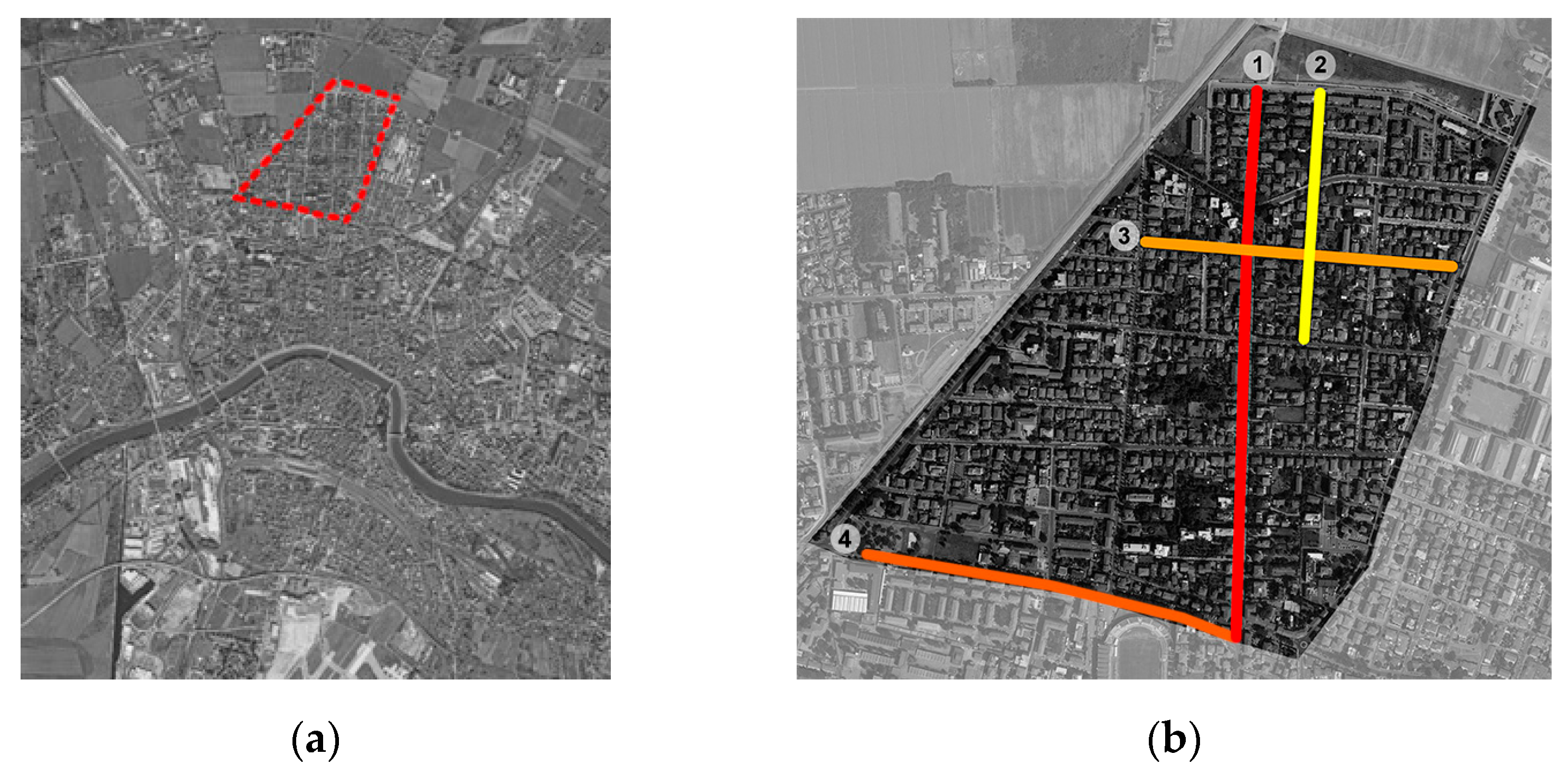


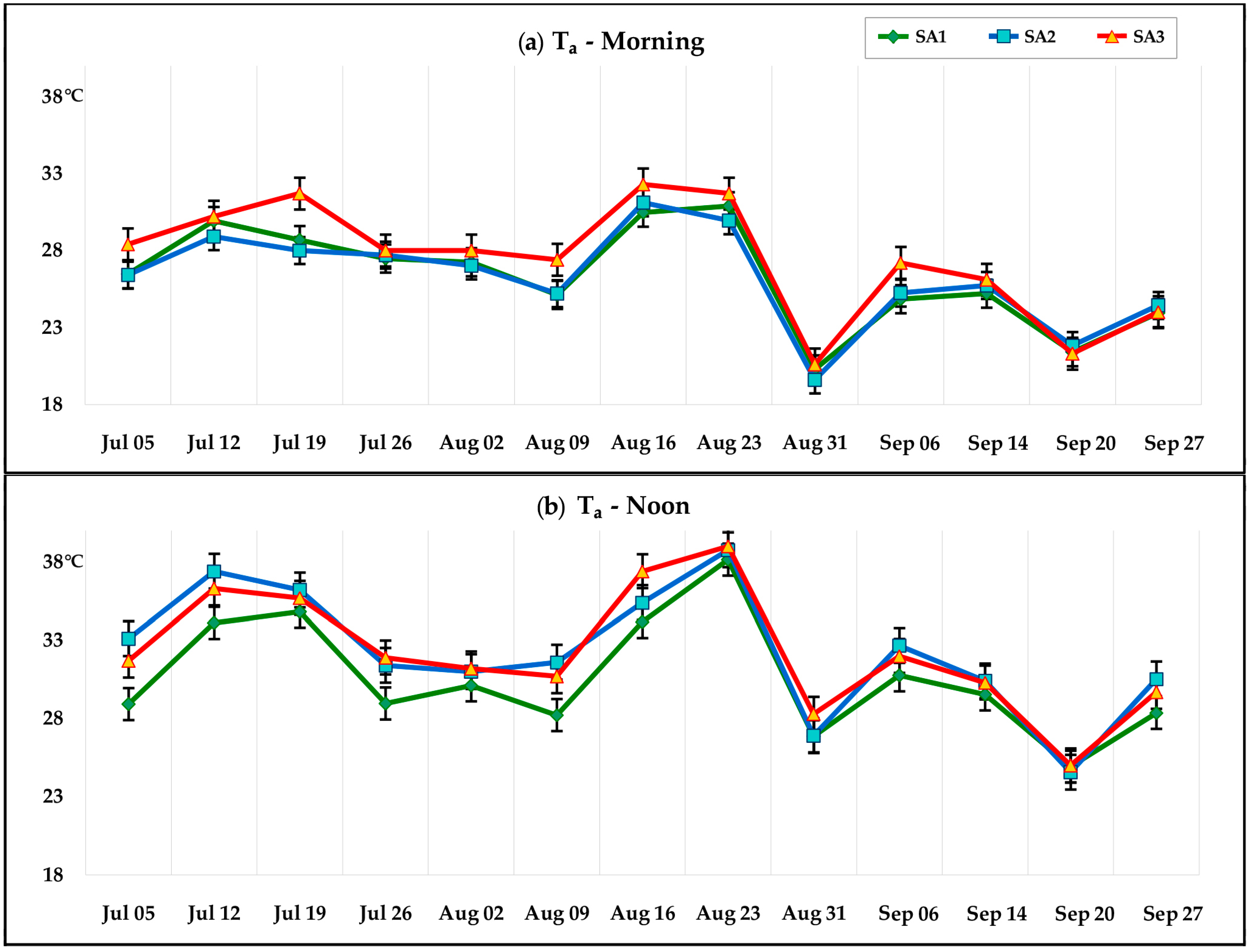
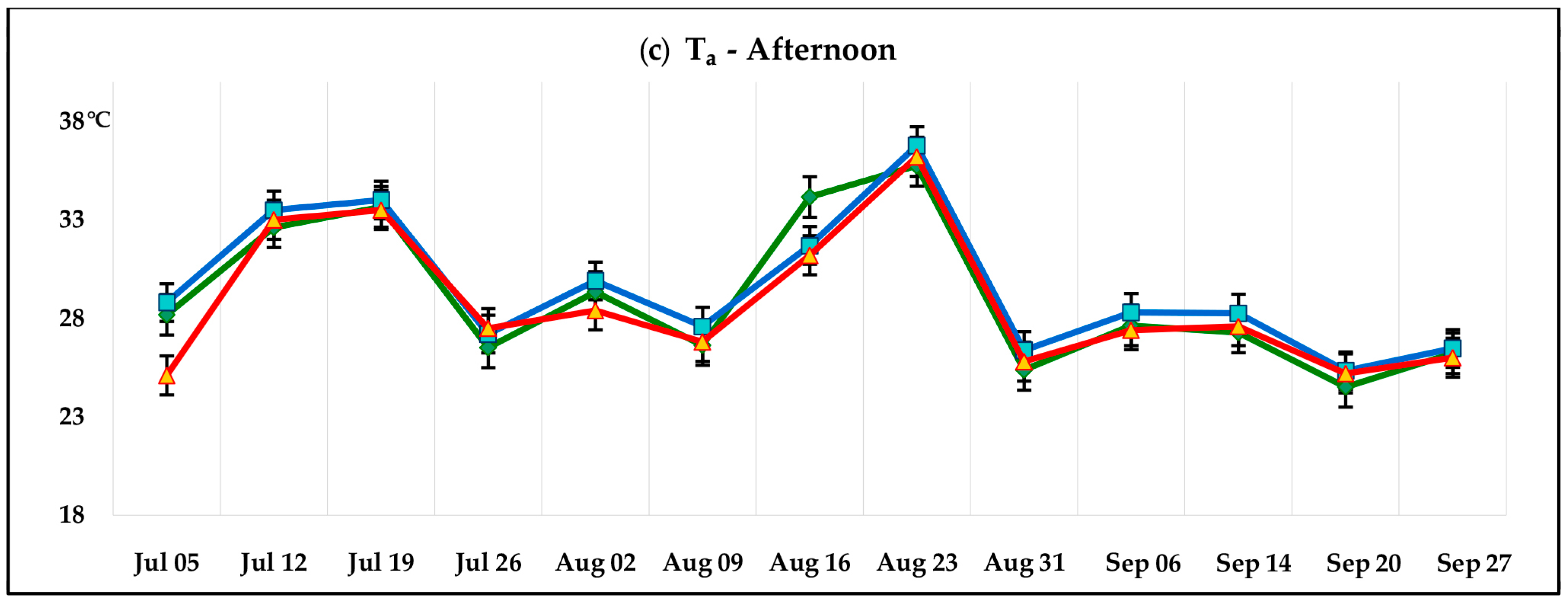



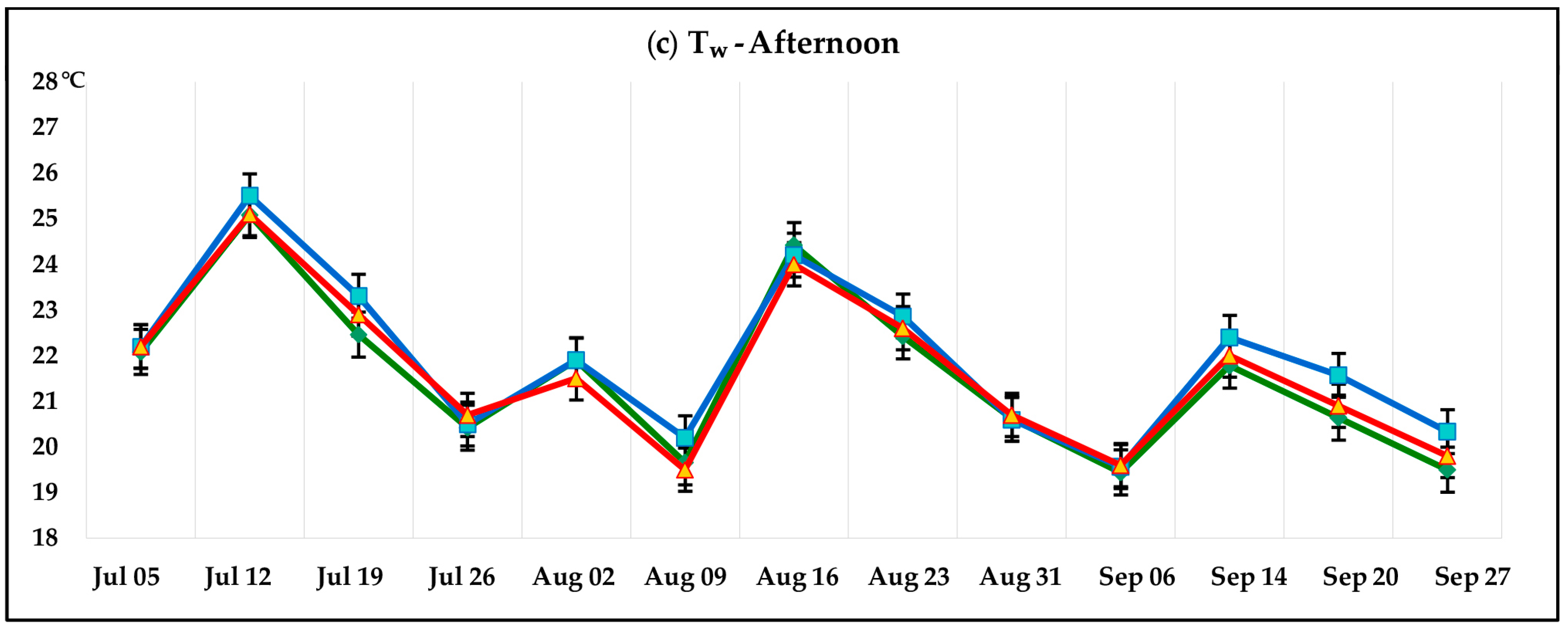
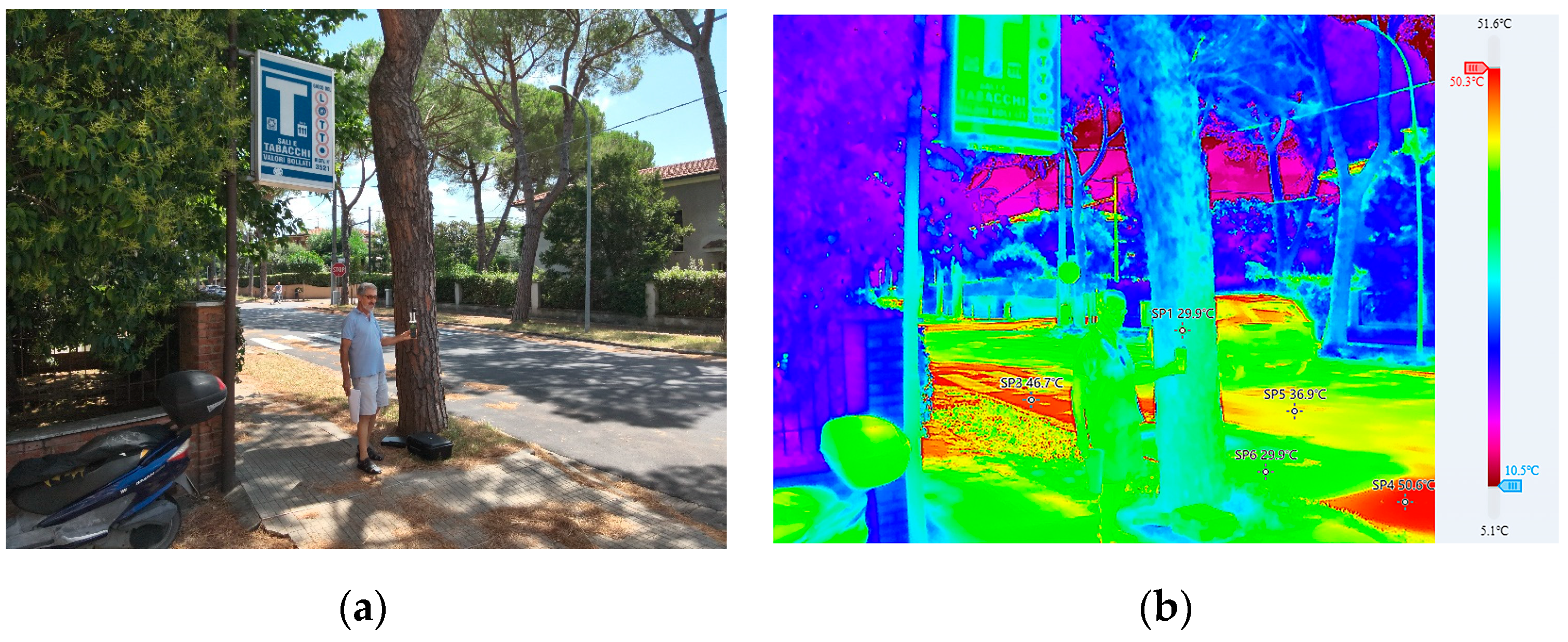

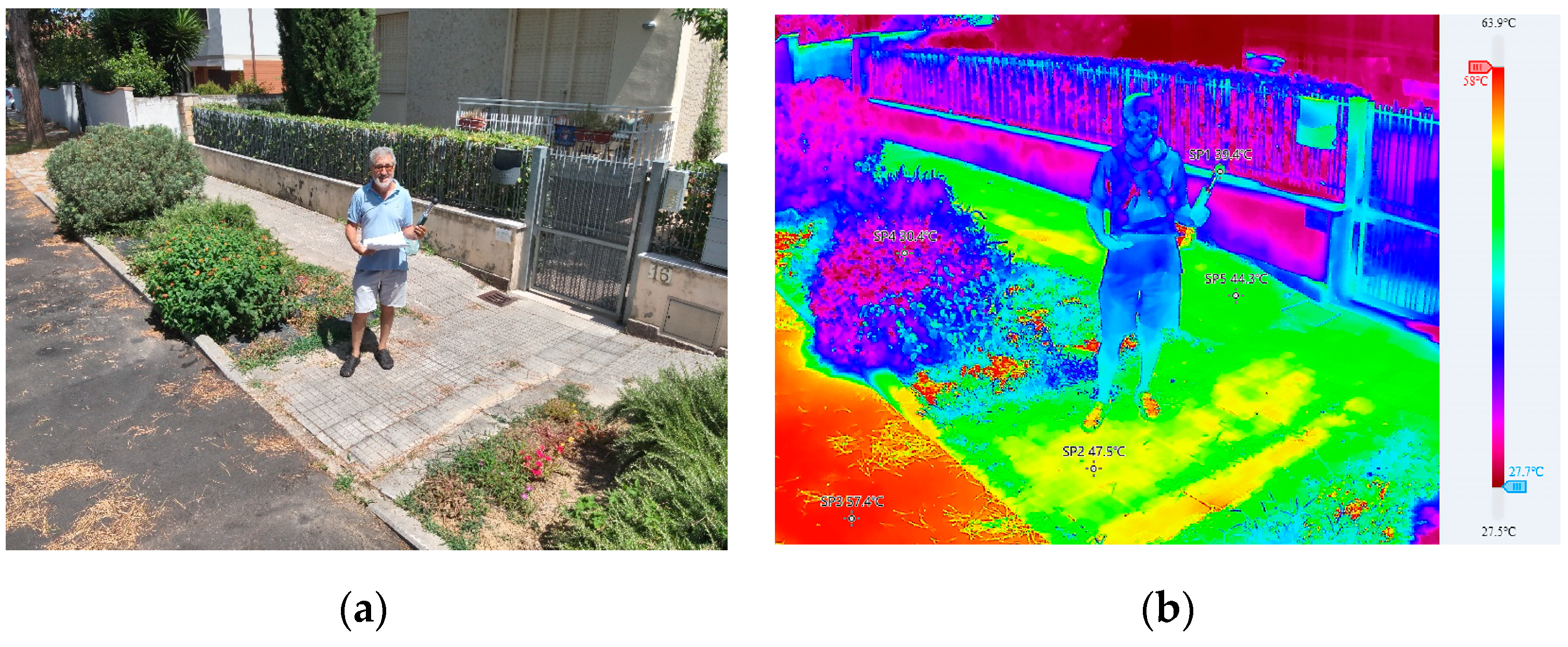
| Monitoring Point | Road Name | Street Arrangement Type |
|---|---|---|
| 1 | Via Giovanni Pisano | Small trees 1 |
| 2 | Small trees | |
| 3 | Small trees | |
| 4 | No trees | |
| 5 | No trees | |
| 6 | Via Fratelli Rosselli | Large trees 2 |
| 7 | No trees | |
| 8 | Large trees | |
| 9 | Large trees | |
| 10 | No trees | |
| 11 | Large trees | |
| 12 | Via Francesco Baracca | Large trees |
| 13 | Large trees | |
| 14 | No trees | |
| 15 | Large trees | |
| 16 | No trees | |
| 17 | Large trees |
| Trees (Number) | Leaf Area (ha) | Canopy Cover (m2) | Carbon Storage (t) | |||||||||
|---|---|---|---|---|---|---|---|---|---|---|---|---|
| Species/ Scenario | S0 | S1 | S2 | S0 | S1 | S2 | S0 | S1 | S2 | S0 | S1 | S2 |
| Acer campestre | 106 | 106 | 106 | 0.53 | 0.53 | 0.53 | 1350 | 1350 | 1350 | 2.94 | 2.94 | 2.94 |
| Acer negundo | 249 | 249 | 249 | 3.69 | 3.69 | 3.69 | 8093 | 8093 | 8093 | 41.84 | 41.84 | 41.84 |
| Cupressus sempervirens | 79 | 79 | 79 | 0.28 | 0.28 | 0.28 | 377 | 377 | 377 | 4.82 | 4.82 | 4.82 |
| Ligustrum lucidum | 68 | 68 | 539 | 0.31 | 0.31 | 1.95 | 995 | 995 | 5789 | 2.62 | 2.62 | 10.75 |
| Morus alba | 81 | 81 | 81 | 0.81 | 0.81 | 0.81 | 3279 | 3279 | 3279 | 19.41 | 19.41 | 19.41 |
| Pinus pinea | 410 | 26 | 26 | 10.83 | 0.82 | 0.82 | 19,679 | 1492 | 1492 | 143.31 | 12.96 | 12.96 |
| Platanus × acerifolia | 100 | 100 | 100 | 3.25 | 3.25 | 3.25 | 5932 | 5932 | 5932 | 35.43 | 35.43 | 35.43 |
| Tilia platyphyllos | 82 | 82 | 82 | 2.21 | 2.21 | 2.21 | 59 | 59 | 59 | 0.22 | 0.22 | 0.22 |
| Other species | 252 | 252 | 252 | 2.28 | 2.28 | 2.28 | 9280 | 9280 | 9280 | 59.51 | 59.51 | 59.51 |
| Total | 1427 | 1043 | 1514 | 24.16 | 14.16 | 15.80 | 49,043 | 30,856 | 35,650 | 310.10 | 179.75 | 187.88 |
| Variation (%) with Respect to S0 | - | −26.9 | +6.1 | - | −41.4 | −34.6 | - | −37.1 | −27.3 | - | −42.0 | −39.4 |
| Avoided Runoff (m³/yr) | Pollution Removal (t/yr) | Gross Carbon Sequestration (t/yr) | CO2eq Sequestration (t/yr) | |||||||||
|---|---|---|---|---|---|---|---|---|---|---|---|---|
| Species/ Scenario | S0 | S1 | S2 | S0 | S1 | S2 | S0 | S1 | S2 | S0 | S1 | S2 |
| Acer campestre | 9.15 | 8.28 | 8.77 | 0.01 | 0.01 | 0.01 | 0.32 | 0.32 | 0.32 | 1.17 | 1.17 | 1.17 |
| Acer negundo | 64.20 | 58.04 | 61.49 | 0.06 | 0.06 | 0.06 | 2.48 | 2.48 | 2.48 | 9.10 | 9.10 | 9.10 |
| Cupressus sempervirens | 4.79 | 4.33 | 4.59 | 0.00 | 0.00 | 0.00 | 0.30 | 0.30 | 0.30 | 1.08 | 1.08 | 1.08 |
| Ligustrum lucidum | 5.32 | 4.81 | 32.44 | 0.00 | 0.00 | 0.03 | 0.28 | 0.28 | 1.59 | 1.02 | 1.02 | 5.85 |
| Morus alba | 14.03 | 12.68 | 13.44 | 0.01 | 0.01 | 0.01 | 1.07 | 1.07 | 1.07 | 3.91 | 3.91 | 3.91 |
| Pinus pinea | 188.33 | 12.92 | 13.69 | 0.17 | 0.01 | 0.01 | 4.32 | 0.34 | 0.34 | 15.83 | 1.26 | 1.26 |
| Platanus × acerifolia | 56.55 | 51.13 | 54.16 | 0.05 | 0.05 | 0.05 | 1.53 | 1.53 | 1.53 | 5.62 | 5.62 | 5.62 |
| Tilia platyphyllos | 36.80 | 34.74 | 36.80 | 0.04 | 0.03 | 0.04 | 0.96 | 0.96 | 0.96 | 3.54 | 3.54 | 3.54 |
| Other Species | 39.59 | 35.86 | 37.95 | 0.01 | 0.01 | 0.01 | 1.58 | 1.58 | 1.58 | 5.88 | 5.88 | 5.88 |
| Total | 418.76 | 222.79 | 263.33 | 0.35 | 0.18 | 0.22 | 12.84 | 8.86 | 10.17 | 47.15 | 32.58 | 37.41 |
| Variation (%) with Respect to S0 | - | −46.8 | −37.1 | - | −48.6 | −37.1 | - | −31.0 | −20.8 | - | −30.9 | −20.7 |
| O3 (kg/yr) | NO2 (kg/yr) | SO2 (kg/yr) | PM2,5 (kg/yr) | |||||||||
|---|---|---|---|---|---|---|---|---|---|---|---|---|
| Species/ Scenario | S0 | S1 | S2 | S0 | S1 | S2 | S0 | S1 | S2 | S0 | S1 | S2 |
| Acer campestre | 5.44 | 5.54 | 5.73 | 2.16 | 2.07 | 2.16 | 0.40 | 0.40 | 0.42 | 0.20 | 0.15 | 0.16 |
| Acer negundo | 38.15 | 38.84 | 40.16 | 15.17 | 14.53 | 15.15 | 2.77 | 2.83 | 2.93 | 1.41 | 1.05 | 1.15 |
| Cupressus sempervirens | 2.85 | 2.90 | 3.00 | 1.13 | 1.08 | 1.13 | 0.21 | 0.21 | 0.22 | 0.10 | 0.08 | 0.09 |
| Ligustrum lucidum | 3.16 | 3.22 | 21.18 | 1.26 | 1.20 | 7.99 | 0.23 | 0.23 | 1.56 | 0.12 | 0.09 | 0.61 |
| Morus alba | 8.34 | 8.49 | 8.77 | 3.31 | 3.18 | 3.31 | 0.61 | 0.62 | 0.64 | 0.31 | 0.23 | 0.25 |
| Pinus pinea | 111.92 | 8.65 | 8.94 | 44.49 | 3.23 | 3.37 | 8.14 | 0.63 | 0.65 | 4.12 | 0.23 | 0.26 |
| Platanus × acerifolia | 33.60 | 34.21 | 35.38 | 13.36 | 12.80 | 13.35 | 2.44 | 2.50 | 2.58 | 1.24 | 0.93 | 1.01 |
| Tilia platyphyllos | 0.17 | 0.17 | 0.18 | 0.07 | 0.06 | 0.07 | 0.01 | 0.01 | 0.01 | 0.01 | 0.00 | 0.01 |
| Other species | 46.21 | 47.04 | 48.65 | 18.37 | 17.60 | 18.36 | 3.36 | 3.43 | 3.56 | 1.70 | 1.28 | 1.40 |
| Total | 249.84 | 149.05 | 171.99 | 99.32 | 55.76 | 64.89 | 18.17 | 10.87 | 12.58 | 9.21 | 4.04 | 4.94 |
| Variation (%) with Respect to S0 | - | −40.3 | −31.2 | - | −43.9 | −34.7 | - | −40.2 | −30.8 | - | −56.2 | −46.3 |
| WBGT Morning (°C) | WBGT Noon (°C) | WBGT Afternoon (°C) | |||||||
|---|---|---|---|---|---|---|---|---|---|
| Day/Street Arrangement | SA1 | SA2 | SA3 | SA1 | SA2 | SA3 | SA1 | SA2 | SA3 |
| July 5 | 23.9 | 23.8 | 25.4 | 25.2 | 28.8 | 28.5 | 25.0 | 25.4 | 25.4 |
| July 12 | 24.8 | 24.9 | 25.9 | 28.3 | 31.1 | 30.4 | 28.1 | 29.1 | 28.8 |
| July 19 | 25.0 | 25.1 | 27.4 | 27.7 | 29.2 | 29.6 | 26.7 | 27.1 | 27.1 |
| July 26 | 23.3 | 24.1 | 26.2 | 24.6 | 26.6 | 27.0 | 23.0 | 23.2 | 23.5 |
| August 2 | 23.1 | 23.3 | 25.3 | 25.4 | 26.9 | 27.3 | 25.2 | 25.5 | 23.9 |
| August 9 | 21.4 | 21.8 | 23.6 | 23.2 | 26.0 | 26.8 | 22.5 | 23.0 | 22.3 |
| August 16 | 26.8 | 28.0 | 28.5 | 29.2 | 30.6 | 31.6 | 28.5 | 27.5 | 27.7 |
| August 23 | 24.5 | 25.7 | 26.7 | 29.5 | 30.5 | 30.6 | 27.2 | 27.9 | 27.4 |
| August 31 | 18.1 | 18.3 | 19.6 | 23.6 | 23.9 | 25.1 | 22.8 | 23.4 | 23.0 |
| September 7 | 20.4 | 21.0 | 22.7 | 24.4 | 26.2 | 25.4 | 22.3 | 22.4 | 22.1 |
| September 14 | 22.8 | 23.9 | 24.5 | 24.9 | 26.3 | 26.2 | 23.7 | 24.6 | 24.0 |
| September 20 | 19.8 | 19.7 | 19.9 | 21.9 | 22.5 | 22.6 | 21.9 | 22.9 | 22.4 |
| September 27 | 19.9 | 21.3 | 21.4 | 22.7 | 25.2 | 25.8 | 21.9 | 22.4 | 22.2 |
Disclaimer/Publisher’s Note: The statements, opinions and data contained in all publications are solely those of the individual author(s) and contributor(s) and not of MDPI and/or the editor(s). MDPI and/or the editor(s) disclaim responsibility for any injury to people or property resulting from any ideas, methods, instructions or products referred to in the content. |
© 2024 by the authors. Licensee MDPI, Basel, Switzerland. This article is an open access article distributed under the terms and conditions of the Creative Commons Attribution (CC BY) license (https://creativecommons.org/licenses/by/4.0/).
Share and Cite
Frosini, G.; Amato, A.; Mugnai, F.; Cinelli, F. The Impact of Trees on the UHI Effect and Urban Environment Quality: A Case Study of a District in Pisa, Italy. Atmosphere 2024, 15, 123. https://doi.org/10.3390/atmos15010123
Frosini G, Amato A, Mugnai F, Cinelli F. The Impact of Trees on the UHI Effect and Urban Environment Quality: A Case Study of a District in Pisa, Italy. Atmosphere. 2024; 15(1):123. https://doi.org/10.3390/atmos15010123
Chicago/Turabian StyleFrosini, Greta, Agnese Amato, Francesca Mugnai, and Fabrizio Cinelli. 2024. "The Impact of Trees on the UHI Effect and Urban Environment Quality: A Case Study of a District in Pisa, Italy" Atmosphere 15, no. 1: 123. https://doi.org/10.3390/atmos15010123





